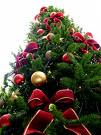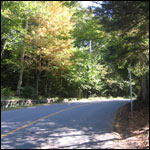…how lovely are your branches!
 My favorite thing about the holiday season is the Christmas tree. I love the whole thing…going to the lot, choosing a tree, the adventure of getting it in/on the car and bringing it home, getting it into the stand and of course, decorating it. I love the twinkle of the lights and I love the smell. I enjoy my tree from the second week of December until New Year’s day, where I sadly undecorated it and pack away all the ornaments until next year.
My favorite thing about the holiday season is the Christmas tree. I love the whole thing…going to the lot, choosing a tree, the adventure of getting it in/on the car and bringing it home, getting it into the stand and of course, decorating it. I love the twinkle of the lights and I love the smell. I enjoy my tree from the second week of December until New Year’s day, where I sadly undecorated it and pack away all the ornaments until next year.
There are lots of things to consider about your tree…here are a few bits of info, some tips gleaned from my favorite blogs (you know that’s you, styleathome.com!), and some of my own thoughts and family traditions.
I would be remiss if I didn’t mention some of the eco pros and cons to both real and fake Christmas trees.
 Real trees come from tree farms, not virgin forest, so they are a sustainably harvested product. But fossil fuels are used to harvest them and get them to the lot where you buy them, and then, to your home — unless you’re dragging them via dogsled!
Real trees come from tree farms, not virgin forest, so they are a sustainably harvested product. But fossil fuels are used to harvest them and get them to the lot where you buy them, and then, to your home — unless you’re dragging them via dogsled!
If you buy a real tree, make sure you check out your city’s post-holiday pick-up rules and schedule, so the tree gets wood-chipped and reused as mulch, rather than being landfill-bound as part of the regular garbage stream.
 Fake trees use large amounts of petroleum in their manufacturing process. However, if you buy one now and use it for decades to come, you are you’re reducing the volume of fossil fuel used to buy real trees each year. If you go faux, commit to your tree. Spend the $$ and make it an investment and don’t change trees every few years.
Fake trees use large amounts of petroleum in their manufacturing process. However, if you buy one now and use it for decades to come, you are you’re reducing the volume of fossil fuel used to buy real trees each year. If you go faux, commit to your tree. Spend the $$ and make it an investment and don’t change trees every few years. Because, I’m just going to say it, there are lots of fake trees that are really awful. Take heart, now more than ever, the look and quality of faux trees has significantly improved so you can easily find one you will be happy to display.
 Potted trees are great if you understand the commitment they require. Most potted Christmas trees actually end up dying. Potted trees need to be kept outdoors. Being moved into an unseasonably warm indoor climate isn’t good for them and they won’t recover when returned outside. So, if you’re open to having your tree on your front porch or back deck full-time until it gets planted in the yard come spring, this might be a good option for you.
Potted trees are great if you understand the commitment they require. Most potted Christmas trees actually end up dying. Potted trees need to be kept outdoors. Being moved into an unseasonably warm indoor climate isn’t good for them and they won’t recover when returned outside. So, if you’re open to having your tree on your front porch or back deck full-time until it gets planted in the yard come spring, this might be a good option for you. I always go for the real deal, the balsam fir. If you can’t find a balsam fir, look for other top choices such as fraser fir, white spruce and scotch pine. These trees are all well known for being aromatic and with branches that retain their needles.
Tip: Before you buy a tree do a quick freshness test. Grab a branch and pull your hand toward you. If the tree is fresh, only five to ten needles should fall off. If you grab a handful of needles, find another tree. Get the vendor at the lot to make a fresh cut to your tree – about 2 inches will do it.
Tip: If you aren’t ready to decorate your tree when you get home, store it in a sheltered area where it will be cool and dry. Cut about two centimeters off the bottom of the trunk and put it in a bucket of water to provide moisture. When you’re ready to bring it inside, make another fresh cut in the trunk and put it in a stand filled with at least four liters of water.
Tip: The Canadian Christmas Tree Growers Association recommends using tree stands that can hold six litres of water or more. Check the water level every day — constant watering will mean your tree will keep its scent, colour and needles.
As a kid, I have fond memories of crawling under the tree and putting ice cubes in the tree stand, so the tree would be slowly watered as the ice melted. I also remember seeing either my mom or dad doing the same…which for some reason, was also incredibly funny at the time. I don’t know if it was necessary, but it sure was fun!
Check out next week’s blog for decorating tips and ideas. In the meantime, happy tree-hunting!


 Real trees come from tree farms, not virgin forest, so they are a sustainably harvested product. But fossil fuels are used to harvest them and get them to the lot where you buy them, and then, to your home — unless you’re dragging them via dogsled!
Real trees come from tree farms, not virgin forest, so they are a sustainably harvested product. But fossil fuels are used to harvest them and get them to the lot where you buy them, and then, to your home — unless you’re dragging them via dogsled!




